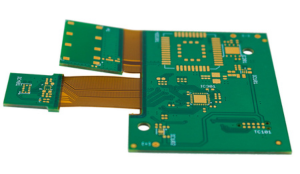Recommendation for baking of Flexible and Rigid-Flex PCB
Since nearly all Flex and Rigid-Flex boards are constructed with polyimide inside and this material is highly hygroscopic in its form, it is strongly recommended to bake the boards to reduce the amount of moisture inside the boards before any type of soldering operation. Without such baking, there is a risk of delaminating, inner-layer separation, or cracking of the hole walls.
Below is a recommendation for baking for different surface treatments, and it is important to note that baking should be kept to a minimum to prevent excessive oxidation and/or intermetallic growth.
Flexible and Rigid-Flex PCB with HASL, Lead-free HASL, and ENIG surface finish.
Flexible PCB:
- Minimum 2 hours at 105° C
Rigid/Flex PCB’s FR4 and Polyimide:
- PCB’s up to 1.0 mm thickness: minimum 2 hours at 120° C
- PCB’s up to 1.8 mm thickness: minimum 4 hours at 120° C
- PCB’s up to 4.0 mm thickness: minimum 6 hours at 120° C
Rigid/Flex PCBs with Polyimide
- All PCB thicknesses: minimum 6 hours at 135° C
Dwell or hold time between baking and soldering is dependent upon the storage conditions. At 50 % relative humidity the recommended hold time is a maximum of 8 hours, yet if the boards can be stored in a vacuum or within the oven at 35°C, then this 8-hour limit can be prolonged.
Oven conditions
Baking should take place in a clean oven to prevent any form of contamination during the baking process. The Printed Circuit boards should also be placed in the oven in such a way that the air can circulate freely around the boards during the baking time.
Solderability concerns
All baking can be considered as advanced aging and therefore may affect the solderability. Therefore the given temperature above must be seen only as recommendations and the customer shall take responsibility to approve the process.
Flexible & Rigid Flex PCB with Immersion Tin, Immersion Silver, and OSP finish
Since all these surface treatments are very sensitive finishes, normal baking is not recommended.
Baking in a vacuum oven (below 50 mbar) may be performed at lowered temperatures and reduced times. In all such cases, the customer has their own responsibility to approve their process
Recommendation for baking of Rigid PCB
This recommendation is for baking rigid PCBs, constructed using epoxy resin (FR4 and FR5).
Epoxy resin is not so hygroscopic, and normally there is no ‘automatic’ need for baking. However, if the boards are old, the packages have been broken or whenever there is a suspect of moisture within the boards, it can be useful to bake prior to assembly/soldering.
Below is a recommendation for baking for different surface treatments, and it is important to note that baking should be kept to a minimum to prevent excessive oxidation and/or intermetallic growth.
Rigid PCB with HASL, Lead-free HASL, and ENIG surface finish
2 hours at 120° C
Dwell or hold time between baking and soldering is dependent upon the storage conditions. Ideally, it should be kept to a minimum, however, it is worth noting that at 75% relative humidity, the recommended maximum hold time is 24 hours.
Oven conditions
Baking should take place in a clean oven to prevent any form of contamination during the baking process. The boards should also be placed in the oven in such a way that the air can circulate freely around the boards during baking time.
Solderability concerns
All baking can be considered as advanced aging and therefore may affect the solderability. Therefore the given temperature above must be seen only as recommendations and the customer shall take responsibility to approve the process.
PCB with Immersion Tin, Immersion Silver, and OSP finish
Since all these surface treatments are very sensitive finishes, normal baking is not recommended. If needed, do trials at a lower temperature and secure the performance with solderability tests.
Baking in a vacuum oven (below 50 mbar) may be performed at lowered temperatures and reduced times. In all such cases, the customer has their own responsibility to approve their process.
EMSxchange Enables you to select a Printed Circuit Board, PCB Assembly, cable & wire harness assembly, and box-build suppliers meeting your Required Electronic Manufacturing Capability, capacity, and Certification Criteria from a global Electronic contact manufacturer base.
EMSxchange takes complete responsibility and ownership for your electronic manufacturing process and all its deliverables from contract manufacturing supplier selection to manufacturing to quality inspection to shipment and delivery to your door.
EMSxchange Electronic Manufacturing Partners Profile includes:
Argus Systems (AESPL) – PCB, PCBA, Cable Assembly, Box Build, Testing.
CerraSystems Inc – HDI PCB, Rigid Flex PCB, RF PCB




